Efficiency Wage Theories: Impact on Pay and Performance Evaluation
VerifiedAdded on 2023/06/10
|8
|1541
|491
Report
AI Summary
This report critically evaluates the theory of efficiency wages, which posits that paying workers above-market wages increases productivity by fostering workplace cohesiveness, responsibility, and loyalty while reducing shirking. It reviews theoretical models such as the health of workers, adverse selection, worker turnover, and shirking, alongside the backward-bending labor supply curve. Empirical evidence, particularly from Singapore's manufacturing sector, is examined, revealing that while wage growth is high, it sometimes outpaces productivity growth, leading to a free-rider effect. The report concludes that efficiency wages can be effective under certain conditions but may not always guarantee increased productivity, as demonstrated by the Singaporean example. Desklib provides access to similar reports and solved assignments for students.
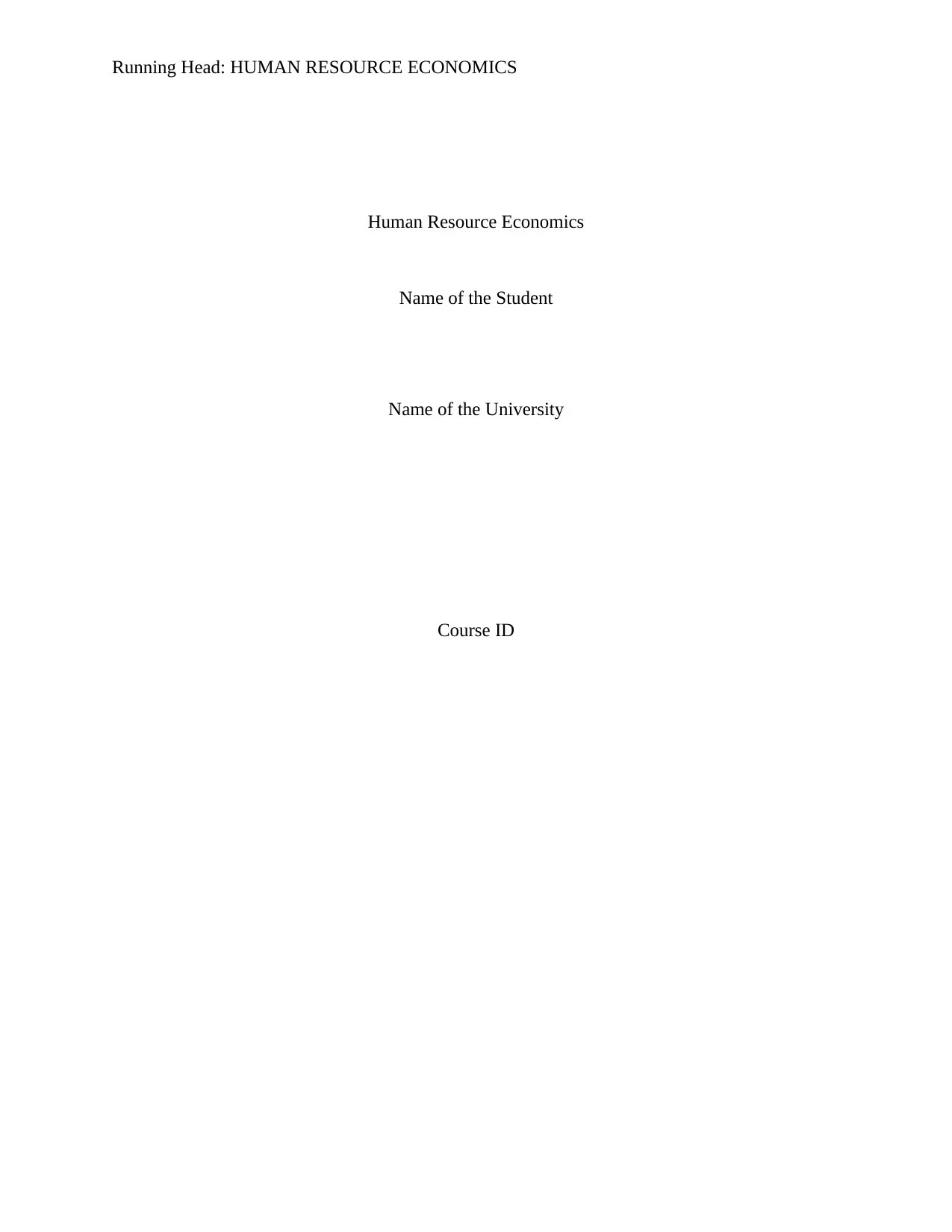
Running Head: HUMAN RESOURCE ECONOMICS
Human Resource Economics
Name of the Student
Name of the University
Course ID
Human Resource Economics
Name of the Student
Name of the University
Course ID
Paraphrase This Document
Need a fresh take? Get an instant paraphrase of this document with our AI Paraphraser
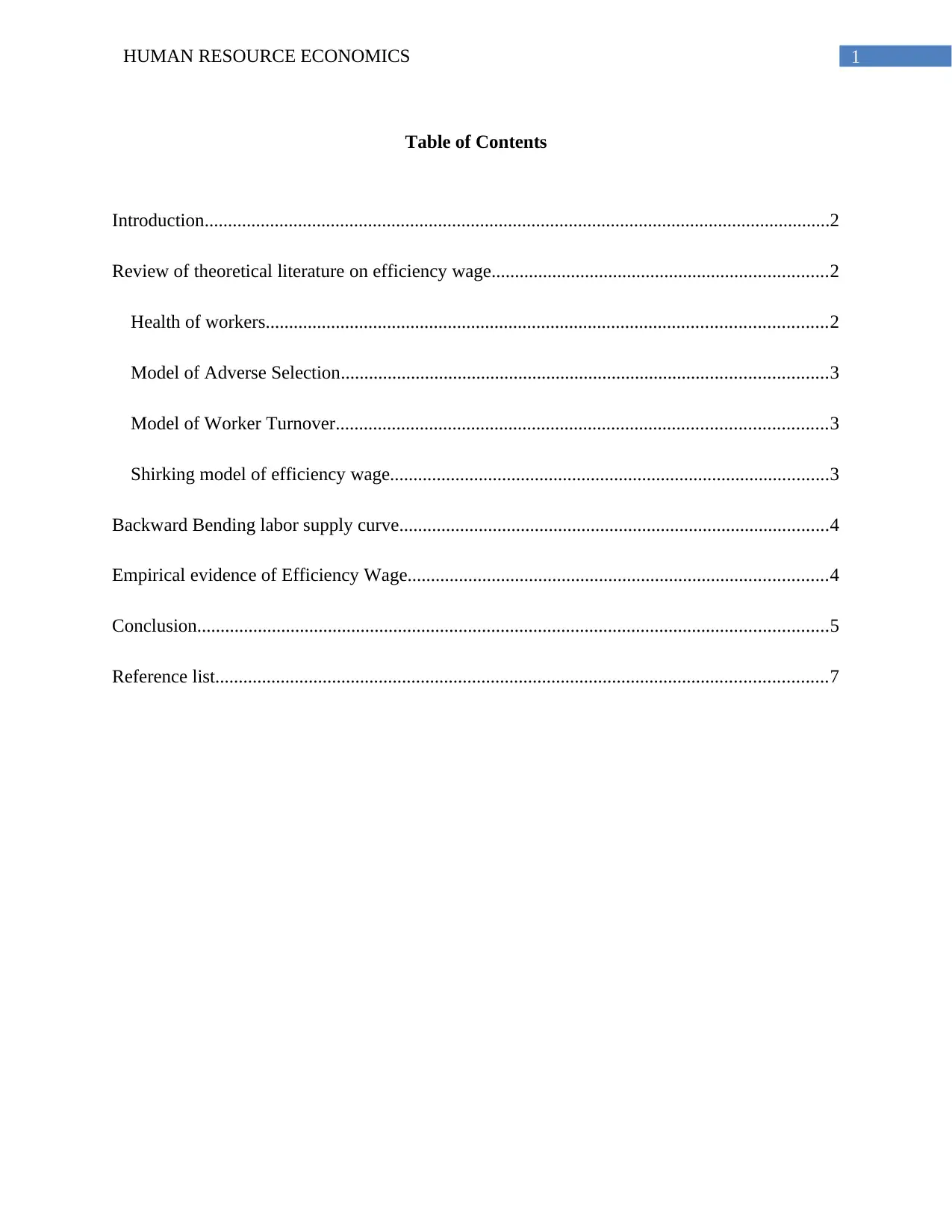
1HUMAN RESOURCE ECONOMICS
Table of Contents
Introduction......................................................................................................................................2
Review of theoretical literature on efficiency wage........................................................................2
Health of workers........................................................................................................................2
Model of Adverse Selection........................................................................................................3
Model of Worker Turnover.........................................................................................................3
Shirking model of efficiency wage..............................................................................................3
Backward Bending labor supply curve............................................................................................4
Empirical evidence of Efficiency Wage..........................................................................................4
Conclusion.......................................................................................................................................5
Reference list...................................................................................................................................7
Table of Contents
Introduction......................................................................................................................................2
Review of theoretical literature on efficiency wage........................................................................2
Health of workers........................................................................................................................2
Model of Adverse Selection........................................................................................................3
Model of Worker Turnover.........................................................................................................3
Shirking model of efficiency wage..............................................................................................3
Backward Bending labor supply curve............................................................................................4
Empirical evidence of Efficiency Wage..........................................................................................4
Conclusion.......................................................................................................................................5
Reference list...................................................................................................................................7
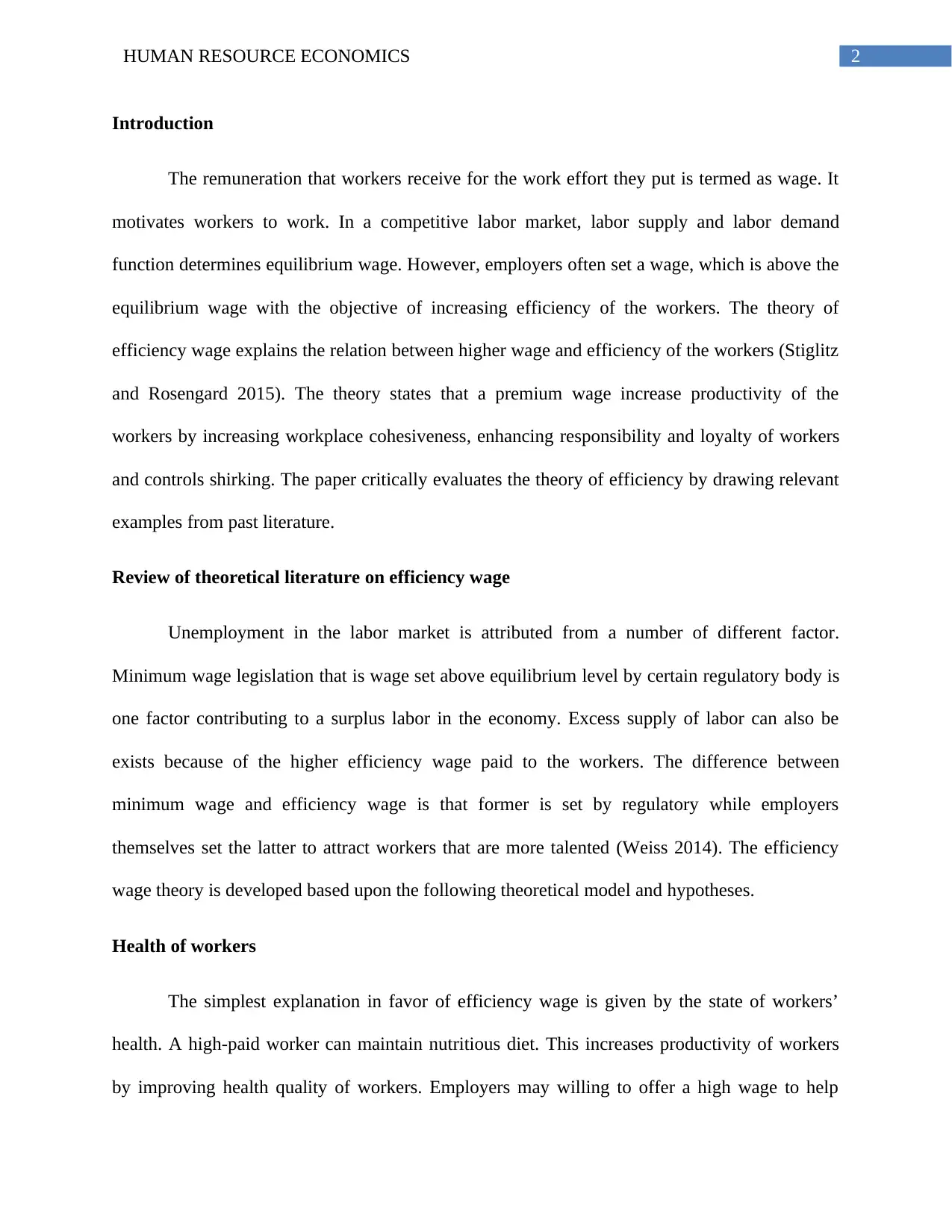
2HUMAN RESOURCE ECONOMICS
Introduction
The remuneration that workers receive for the work effort they put is termed as wage. It
motivates workers to work. In a competitive labor market, labor supply and labor demand
function determines equilibrium wage. However, employers often set a wage, which is above the
equilibrium wage with the objective of increasing efficiency of the workers. The theory of
efficiency wage explains the relation between higher wage and efficiency of the workers (Stiglitz
and Rosengard 2015). The theory states that a premium wage increase productivity of the
workers by increasing workplace cohesiveness, enhancing responsibility and loyalty of workers
and controls shirking. The paper critically evaluates the theory of efficiency by drawing relevant
examples from past literature.
Review of theoretical literature on efficiency wage
Unemployment in the labor market is attributed from a number of different factor.
Minimum wage legislation that is wage set above equilibrium level by certain regulatory body is
one factor contributing to a surplus labor in the economy. Excess supply of labor can also be
exists because of the higher efficiency wage paid to the workers. The difference between
minimum wage and efficiency wage is that former is set by regulatory while employers
themselves set the latter to attract workers that are more talented (Weiss 2014). The efficiency
wage theory is developed based upon the following theoretical model and hypotheses.
Health of workers
The simplest explanation in favor of efficiency wage is given by the state of workers’
health. A high-paid worker can maintain nutritious diet. This increases productivity of workers
by improving health quality of workers. Employers may willing to offer a high wage to help
Introduction
The remuneration that workers receive for the work effort they put is termed as wage. It
motivates workers to work. In a competitive labor market, labor supply and labor demand
function determines equilibrium wage. However, employers often set a wage, which is above the
equilibrium wage with the objective of increasing efficiency of the workers. The theory of
efficiency wage explains the relation between higher wage and efficiency of the workers (Stiglitz
and Rosengard 2015). The theory states that a premium wage increase productivity of the
workers by increasing workplace cohesiveness, enhancing responsibility and loyalty of workers
and controls shirking. The paper critically evaluates the theory of efficiency by drawing relevant
examples from past literature.
Review of theoretical literature on efficiency wage
Unemployment in the labor market is attributed from a number of different factor.
Minimum wage legislation that is wage set above equilibrium level by certain regulatory body is
one factor contributing to a surplus labor in the economy. Excess supply of labor can also be
exists because of the higher efficiency wage paid to the workers. The difference between
minimum wage and efficiency wage is that former is set by regulatory while employers
themselves set the latter to attract workers that are more talented (Weiss 2014). The efficiency
wage theory is developed based upon the following theoretical model and hypotheses.
Health of workers
The simplest explanation in favor of efficiency wage is given by the state of workers’
health. A high-paid worker can maintain nutritious diet. This increases productivity of workers
by improving health quality of workers. Employers may willing to offer a high wage to help
⊘ This is a preview!⊘
Do you want full access?
Subscribe today to unlock all pages.

Trusted by 1+ million students worldwide
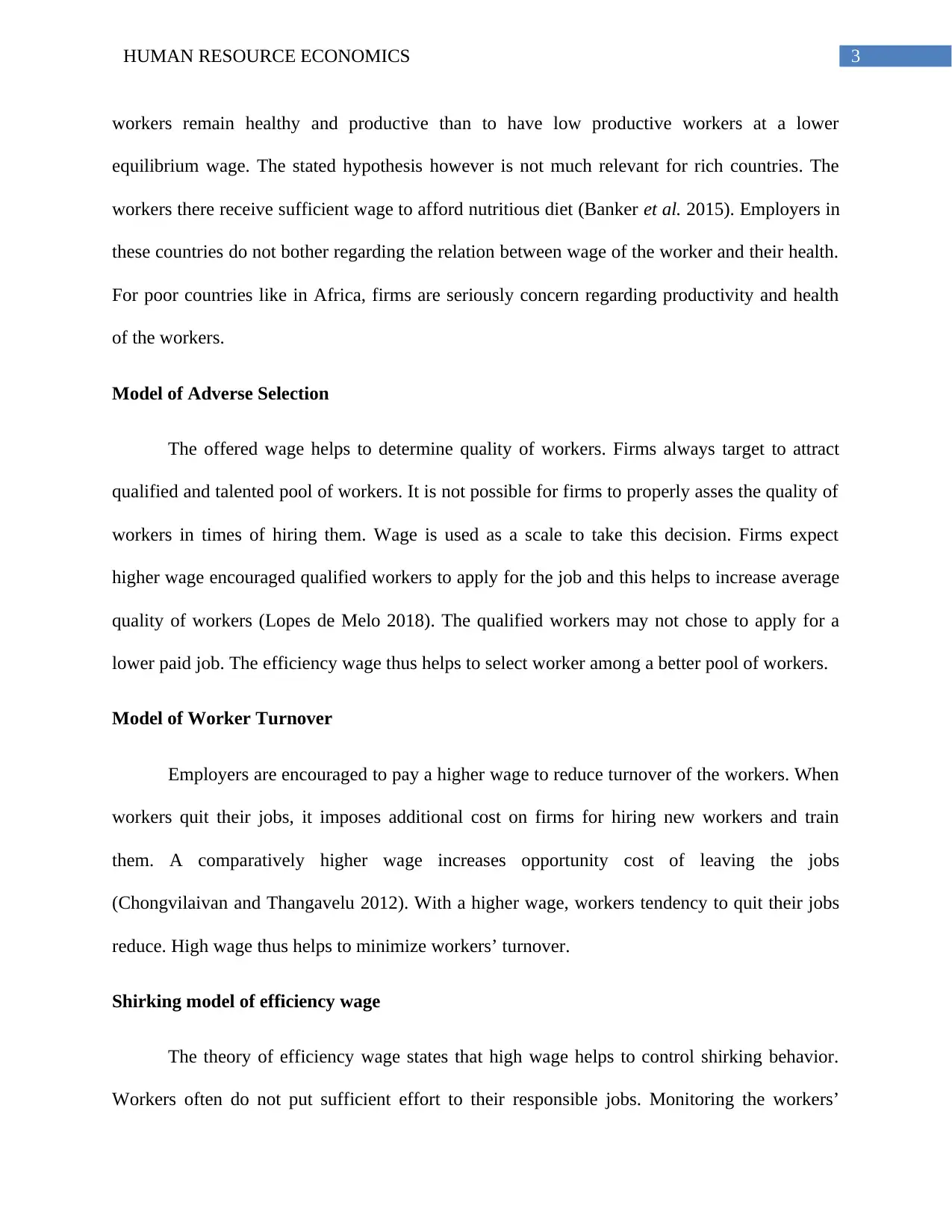
3HUMAN RESOURCE ECONOMICS
workers remain healthy and productive than to have low productive workers at a lower
equilibrium wage. The stated hypothesis however is not much relevant for rich countries. The
workers there receive sufficient wage to afford nutritious diet (Banker et al. 2015). Employers in
these countries do not bother regarding the relation between wage of the worker and their health.
For poor countries like in Africa, firms are seriously concern regarding productivity and health
of the workers.
Model of Adverse Selection
The offered wage helps to determine quality of workers. Firms always target to attract
qualified and talented pool of workers. It is not possible for firms to properly asses the quality of
workers in times of hiring them. Wage is used as a scale to take this decision. Firms expect
higher wage encouraged qualified workers to apply for the job and this helps to increase average
quality of workers (Lopes de Melo 2018). The qualified workers may not chose to apply for a
lower paid job. The efficiency wage thus helps to select worker among a better pool of workers.
Model of Worker Turnover
Employers are encouraged to pay a higher wage to reduce turnover of the workers. When
workers quit their jobs, it imposes additional cost on firms for hiring new workers and train
them. A comparatively higher wage increases opportunity cost of leaving the jobs
(Chongvilaivan and Thangavelu 2012). With a higher wage, workers tendency to quit their jobs
reduce. High wage thus helps to minimize workers’ turnover.
Shirking model of efficiency wage
The theory of efficiency wage states that high wage helps to control shirking behavior.
Workers often do not put sufficient effort to their responsible jobs. Monitoring the workers’
workers remain healthy and productive than to have low productive workers at a lower
equilibrium wage. The stated hypothesis however is not much relevant for rich countries. The
workers there receive sufficient wage to afford nutritious diet (Banker et al. 2015). Employers in
these countries do not bother regarding the relation between wage of the worker and their health.
For poor countries like in Africa, firms are seriously concern regarding productivity and health
of the workers.
Model of Adverse Selection
The offered wage helps to determine quality of workers. Firms always target to attract
qualified and talented pool of workers. It is not possible for firms to properly asses the quality of
workers in times of hiring them. Wage is used as a scale to take this decision. Firms expect
higher wage encouraged qualified workers to apply for the job and this helps to increase average
quality of workers (Lopes de Melo 2018). The qualified workers may not chose to apply for a
lower paid job. The efficiency wage thus helps to select worker among a better pool of workers.
Model of Worker Turnover
Employers are encouraged to pay a higher wage to reduce turnover of the workers. When
workers quit their jobs, it imposes additional cost on firms for hiring new workers and train
them. A comparatively higher wage increases opportunity cost of leaving the jobs
(Chongvilaivan and Thangavelu 2012). With a higher wage, workers tendency to quit their jobs
reduce. High wage thus helps to minimize workers’ turnover.
Shirking model of efficiency wage
The theory of efficiency wage states that high wage helps to control shirking behavior.
Workers often do not put sufficient effort to their responsible jobs. Monitoring the workers’
Paraphrase This Document
Need a fresh take? Get an instant paraphrase of this document with our AI Paraphraser
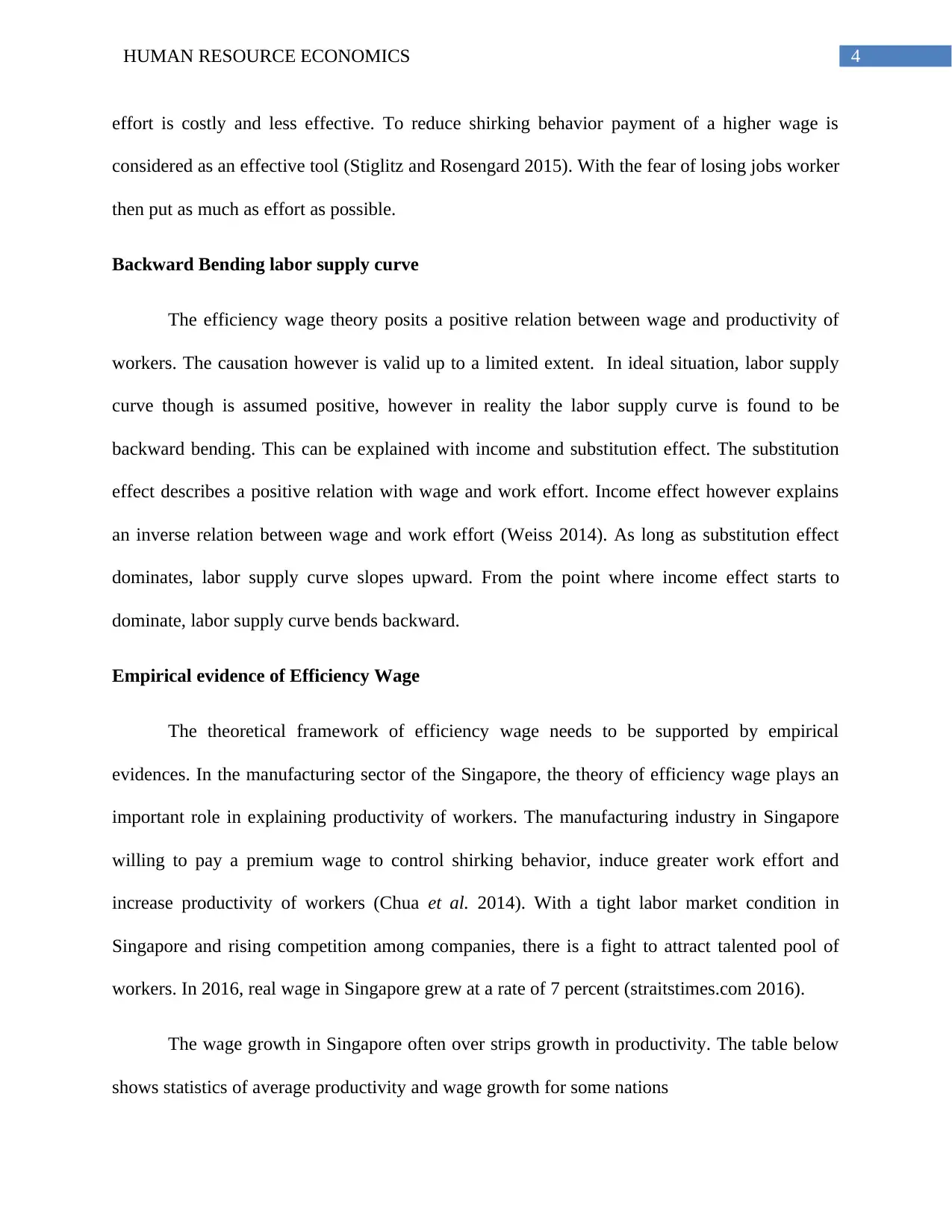
4HUMAN RESOURCE ECONOMICS
effort is costly and less effective. To reduce shirking behavior payment of a higher wage is
considered as an effective tool (Stiglitz and Rosengard 2015). With the fear of losing jobs worker
then put as much as effort as possible.
Backward Bending labor supply curve
The efficiency wage theory posits a positive relation between wage and productivity of
workers. The causation however is valid up to a limited extent. In ideal situation, labor supply
curve though is assumed positive, however in reality the labor supply curve is found to be
backward bending. This can be explained with income and substitution effect. The substitution
effect describes a positive relation with wage and work effort. Income effect however explains
an inverse relation between wage and work effort (Weiss 2014). As long as substitution effect
dominates, labor supply curve slopes upward. From the point where income effect starts to
dominate, labor supply curve bends backward.
Empirical evidence of Efficiency Wage
The theoretical framework of efficiency wage needs to be supported by empirical
evidences. In the manufacturing sector of the Singapore, the theory of efficiency wage plays an
important role in explaining productivity of workers. The manufacturing industry in Singapore
willing to pay a premium wage to control shirking behavior, induce greater work effort and
increase productivity of workers (Chua et al. 2014). With a tight labor market condition in
Singapore and rising competition among companies, there is a fight to attract talented pool of
workers. In 2016, real wage in Singapore grew at a rate of 7 percent (straitstimes.com 2016).
The wage growth in Singapore often over strips growth in productivity. The table below
shows statistics of average productivity and wage growth for some nations
effort is costly and less effective. To reduce shirking behavior payment of a higher wage is
considered as an effective tool (Stiglitz and Rosengard 2015). With the fear of losing jobs worker
then put as much as effort as possible.
Backward Bending labor supply curve
The efficiency wage theory posits a positive relation between wage and productivity of
workers. The causation however is valid up to a limited extent. In ideal situation, labor supply
curve though is assumed positive, however in reality the labor supply curve is found to be
backward bending. This can be explained with income and substitution effect. The substitution
effect describes a positive relation with wage and work effort. Income effect however explains
an inverse relation between wage and work effort (Weiss 2014). As long as substitution effect
dominates, labor supply curve slopes upward. From the point where income effect starts to
dominate, labor supply curve bends backward.
Empirical evidence of Efficiency Wage
The theoretical framework of efficiency wage needs to be supported by empirical
evidences. In the manufacturing sector of the Singapore, the theory of efficiency wage plays an
important role in explaining productivity of workers. The manufacturing industry in Singapore
willing to pay a premium wage to control shirking behavior, induce greater work effort and
increase productivity of workers (Chua et al. 2014). With a tight labor market condition in
Singapore and rising competition among companies, there is a fight to attract talented pool of
workers. In 2016, real wage in Singapore grew at a rate of 7 percent (straitstimes.com 2016).
The wage growth in Singapore often over strips growth in productivity. The table below
shows statistics of average productivity and wage growth for some nations
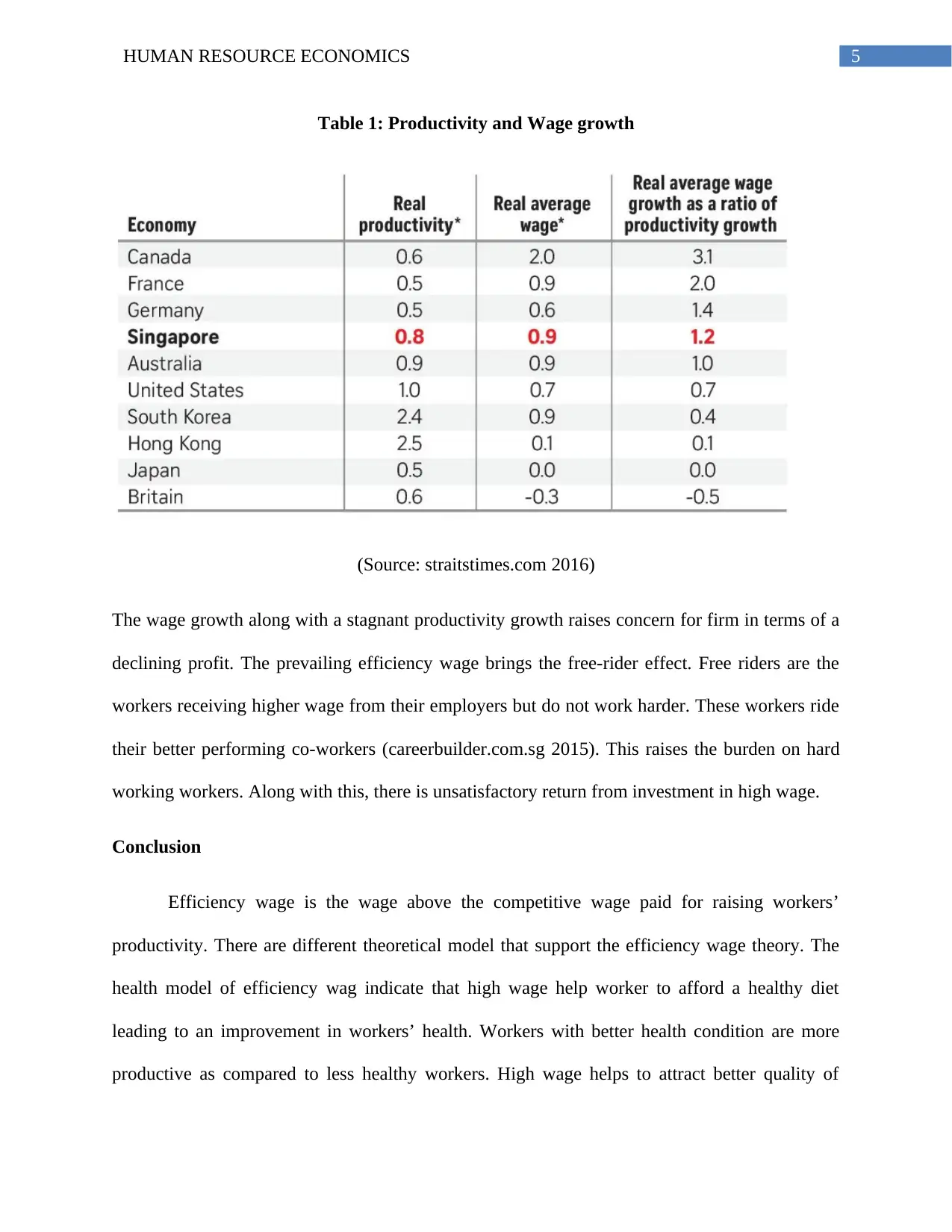
5HUMAN RESOURCE ECONOMICS
Table 1: Productivity and Wage growth
(Source: straitstimes.com 2016)
The wage growth along with a stagnant productivity growth raises concern for firm in terms of a
declining profit. The prevailing efficiency wage brings the free-rider effect. Free riders are the
workers receiving higher wage from their employers but do not work harder. These workers ride
their better performing co-workers (careerbuilder.com.sg 2015). This raises the burden on hard
working workers. Along with this, there is unsatisfactory return from investment in high wage.
Conclusion
Efficiency wage is the wage above the competitive wage paid for raising workers’
productivity. There are different theoretical model that support the efficiency wage theory. The
health model of efficiency wag indicate that high wage help worker to afford a healthy diet
leading to an improvement in workers’ health. Workers with better health condition are more
productive as compared to less healthy workers. High wage helps to attract better quality of
Table 1: Productivity and Wage growth
(Source: straitstimes.com 2016)
The wage growth along with a stagnant productivity growth raises concern for firm in terms of a
declining profit. The prevailing efficiency wage brings the free-rider effect. Free riders are the
workers receiving higher wage from their employers but do not work harder. These workers ride
their better performing co-workers (careerbuilder.com.sg 2015). This raises the burden on hard
working workers. Along with this, there is unsatisfactory return from investment in high wage.
Conclusion
Efficiency wage is the wage above the competitive wage paid for raising workers’
productivity. There are different theoretical model that support the efficiency wage theory. The
health model of efficiency wag indicate that high wage help worker to afford a healthy diet
leading to an improvement in workers’ health. Workers with better health condition are more
productive as compared to less healthy workers. High wage helps to attract better quality of
⊘ This is a preview!⊘
Do you want full access?
Subscribe today to unlock all pages.

Trusted by 1+ million students worldwide
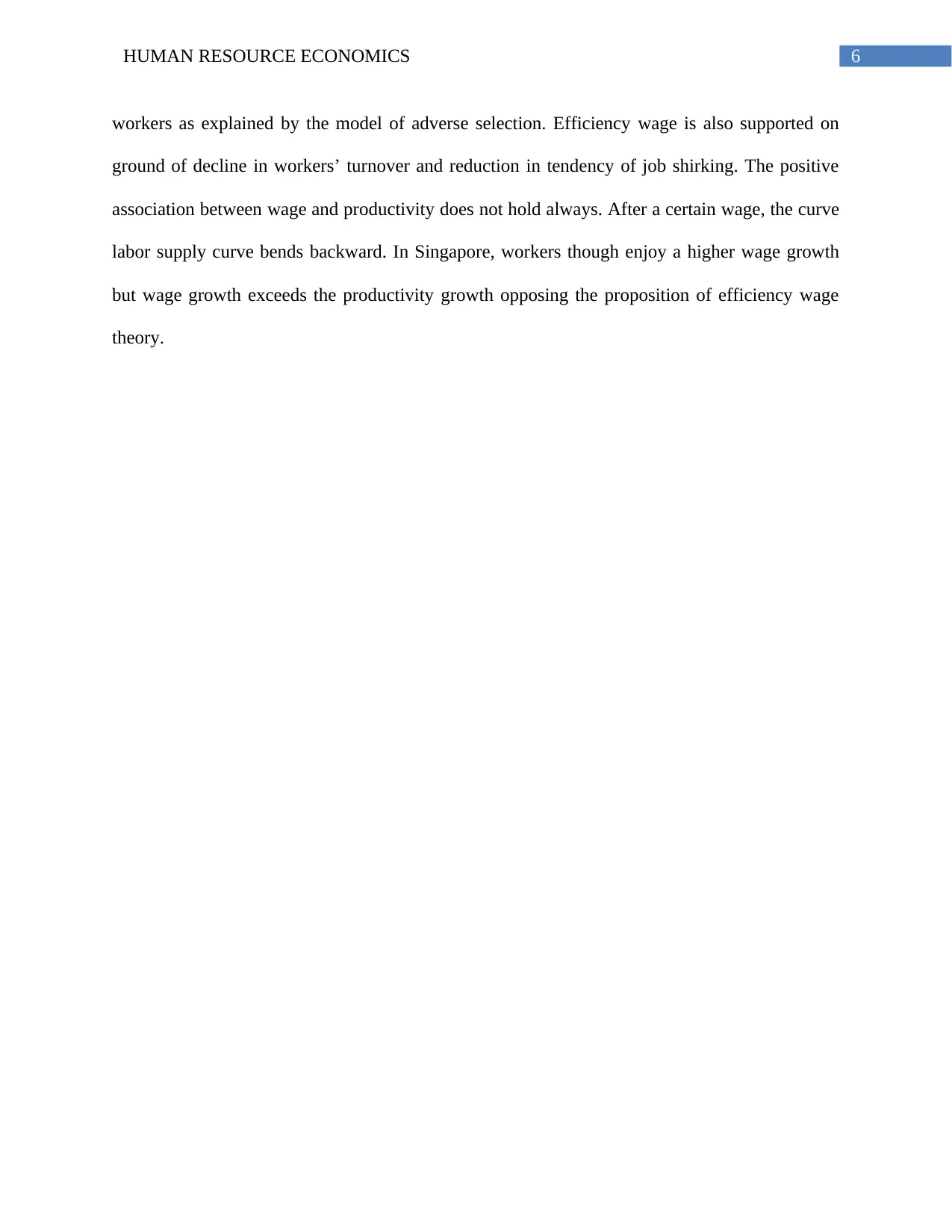
6HUMAN RESOURCE ECONOMICS
workers as explained by the model of adverse selection. Efficiency wage is also supported on
ground of decline in workers’ turnover and reduction in tendency of job shirking. The positive
association between wage and productivity does not hold always. After a certain wage, the curve
labor supply curve bends backward. In Singapore, workers though enjoy a higher wage growth
but wage growth exceeds the productivity growth opposing the proposition of efficiency wage
theory.
workers as explained by the model of adverse selection. Efficiency wage is also supported on
ground of decline in workers’ turnover and reduction in tendency of job shirking. The positive
association between wage and productivity does not hold always. After a certain wage, the curve
labor supply curve bends backward. In Singapore, workers though enjoy a higher wage growth
but wage growth exceeds the productivity growth opposing the proposition of efficiency wage
theory.
Paraphrase This Document
Need a fresh take? Get an instant paraphrase of this document with our AI Paraphraser
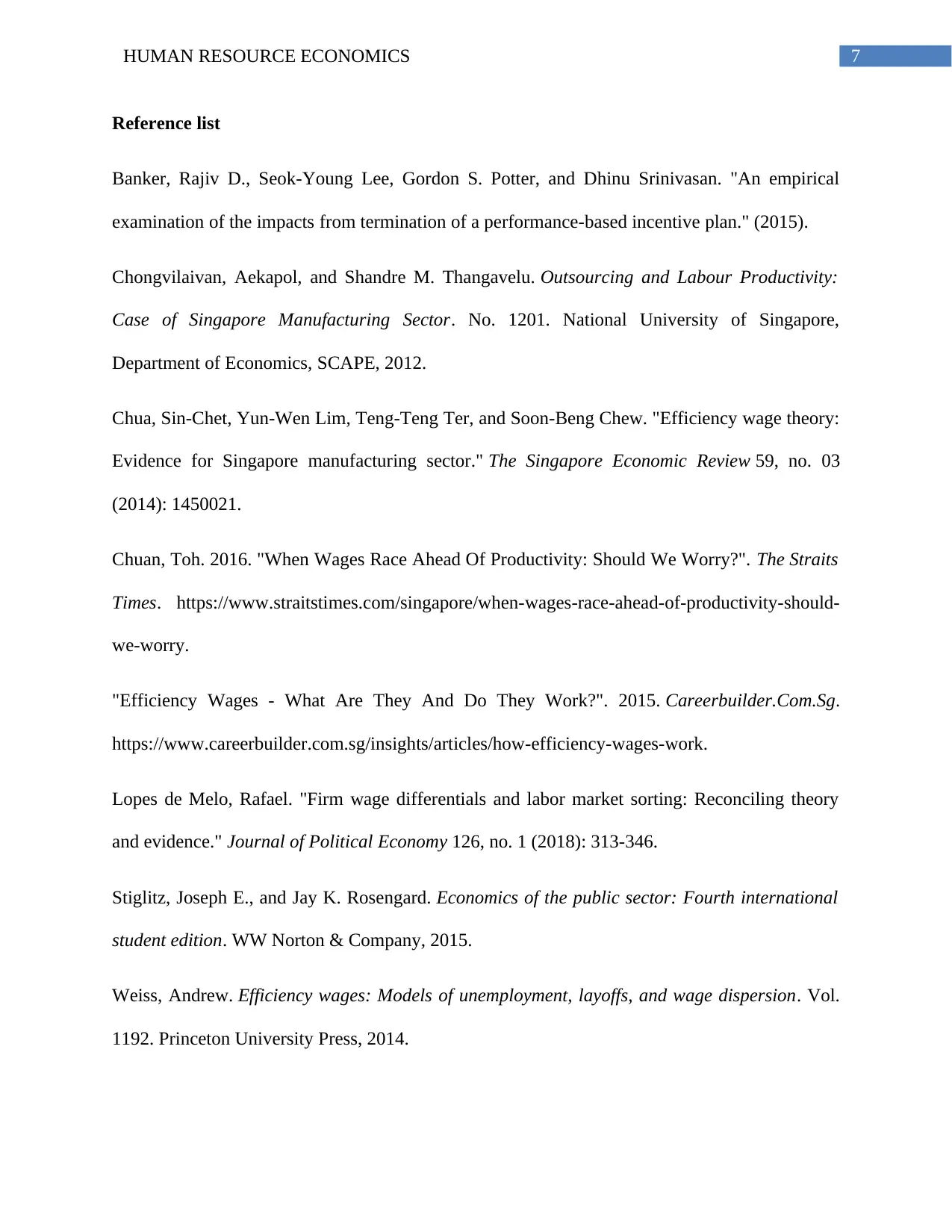
7HUMAN RESOURCE ECONOMICS
Reference list
Banker, Rajiv D., Seok-Young Lee, Gordon S. Potter, and Dhinu Srinivasan. "An empirical
examination of the impacts from termination of a performance-based incentive plan." (2015).
Chongvilaivan, Aekapol, and Shandre M. Thangavelu. Outsourcing and Labour Productivity:
Case of Singapore Manufacturing Sector. No. 1201. National University of Singapore,
Department of Economics, SCAPE, 2012.
Chua, Sin-Chet, Yun-Wen Lim, Teng-Teng Ter, and Soon-Beng Chew. "Efficiency wage theory:
Evidence for Singapore manufacturing sector." The Singapore Economic Review 59, no. 03
(2014): 1450021.
Chuan, Toh. 2016. "When Wages Race Ahead Of Productivity: Should We Worry?". The Straits
Times. https://www.straitstimes.com/singapore/when-wages-race-ahead-of-productivity-should-
we-worry.
"Efficiency Wages - What Are They And Do They Work?". 2015. Careerbuilder.Com.Sg.
https://www.careerbuilder.com.sg/insights/articles/how-efficiency-wages-work.
Lopes de Melo, Rafael. "Firm wage differentials and labor market sorting: Reconciling theory
and evidence." Journal of Political Economy 126, no. 1 (2018): 313-346.
Stiglitz, Joseph E., and Jay K. Rosengard. Economics of the public sector: Fourth international
student edition. WW Norton & Company, 2015.
Weiss, Andrew. Efficiency wages: Models of unemployment, layoffs, and wage dispersion. Vol.
1192. Princeton University Press, 2014.
Reference list
Banker, Rajiv D., Seok-Young Lee, Gordon S. Potter, and Dhinu Srinivasan. "An empirical
examination of the impacts from termination of a performance-based incentive plan." (2015).
Chongvilaivan, Aekapol, and Shandre M. Thangavelu. Outsourcing and Labour Productivity:
Case of Singapore Manufacturing Sector. No. 1201. National University of Singapore,
Department of Economics, SCAPE, 2012.
Chua, Sin-Chet, Yun-Wen Lim, Teng-Teng Ter, and Soon-Beng Chew. "Efficiency wage theory:
Evidence for Singapore manufacturing sector." The Singapore Economic Review 59, no. 03
(2014): 1450021.
Chuan, Toh. 2016. "When Wages Race Ahead Of Productivity: Should We Worry?". The Straits
Times. https://www.straitstimes.com/singapore/when-wages-race-ahead-of-productivity-should-
we-worry.
"Efficiency Wages - What Are They And Do They Work?". 2015. Careerbuilder.Com.Sg.
https://www.careerbuilder.com.sg/insights/articles/how-efficiency-wages-work.
Lopes de Melo, Rafael. "Firm wage differentials and labor market sorting: Reconciling theory
and evidence." Journal of Political Economy 126, no. 1 (2018): 313-346.
Stiglitz, Joseph E., and Jay K. Rosengard. Economics of the public sector: Fourth international
student edition. WW Norton & Company, 2015.
Weiss, Andrew. Efficiency wages: Models of unemployment, layoffs, and wage dispersion. Vol.
1192. Princeton University Press, 2014.
1 out of 8
Related Documents
Your All-in-One AI-Powered Toolkit for Academic Success.
+13062052269
info@desklib.com
Available 24*7 on WhatsApp / Email
![[object Object]](/_next/static/media/star-bottom.7253800d.svg)
Unlock your academic potential
Copyright © 2020–2025 A2Z Services. All Rights Reserved. Developed and managed by ZUCOL.





